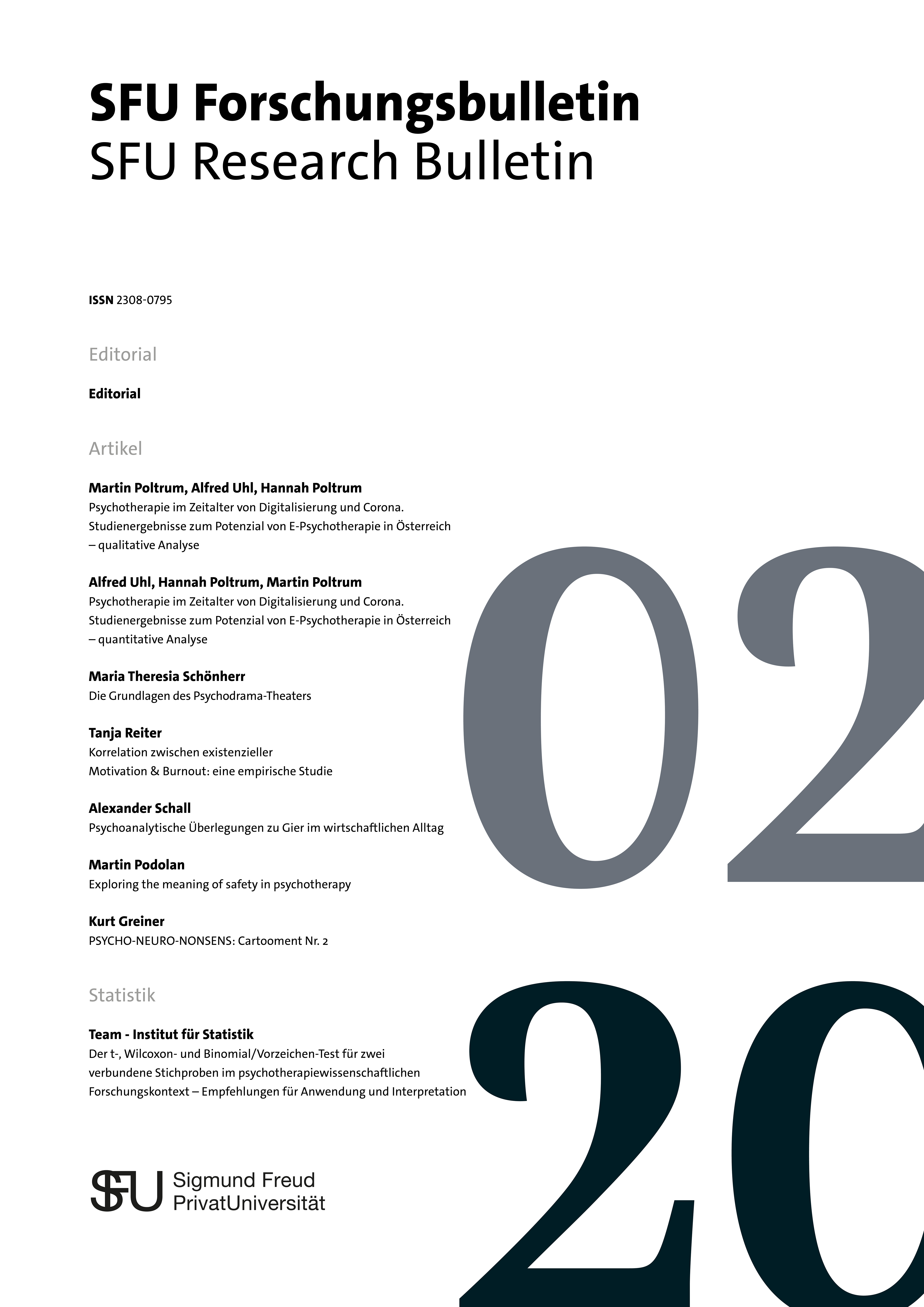Correlation between Existential motivation & burnout
An empirical study
DOI:
https://doi.org/10.15135/2020.8.2.76-91Abstract
The phenomenon of burnout is reflected from an existential analytic point of view. The presented study shall examine a clear correlation between a lack of existential motivation and burnout. Measuring instruments used are the TEM (Test zur existentiellen Motivation) and the BOSS (Burnout Screening Skalen). The results found indicate a clear correlation between the existing theoretical existential views on burnout and show a statistically secured strong correlation between burnout and a lack of meaning.
References
Burisch, M. (2010). Das Burnout-Syndrom: Theorie der inneren Erschöpfung. Heidelberg: Springer. [Original publiziert 1989]
Eckhard, P. (2000). Skalen zur Erfassung existentieller Motivation, Selbstwert und Sinn-erleben. Unveröffentlichte Dissertation. Universität Wien.
Efimova, I. (2012). Warum die Beine nicht tragen – wie Burnout den Willen beeinflusst. Existenzanalyse, 29(2), 71‒76.
Enzmann, D., & Kleiber, D. (1989). Helfer leiden. Stress und Burnout in psychosozialen Berufen. Heidelberg: Asanger.
Frankl, V. (1959). Grundriss der Existenzanalyse und Logotherapie. In V. Frankl, V. v. Gebsattel & J.H. Schultz (Hrsg.), Handbuch der Neurosenlehre und Psychotherapie (S. 663‒736). München: USB.
Frankl, V.E. (1984). Der leidende Mensch. Anthropologische Grundlagen der Psychotherapie. Bern: Huber.
Freudenberger, H.J. (1974). Staff burn-out. Journal of Social Issues, 30, 159‒165.
Geuenich, K., & Hagemann, W. (2014). Burnout-Screening Skalen. Manual. Göttingen: Hogrefe.
Hedderich, J., Sachs, L. (2016). Angewandte Statistik. Methodensammlung mit R. Springer Verlag.
Kilpatrick, A. O. (1986). Burnout: An Empirical Assessment. Unpublishes doctoral dissertation. Athens: University of Georgia.
Kleiber, D., & Enzmann, D. (1990). Burnout. Eine internationale Bibliographie. An International Bibliography. Göttingen: Verlag für Psychologie Hogrefe.
Leibovici-Mühlberger, M. (2013). Die Burnout-Lüge – Was uns wirklich schwächt – Wie wir stark bleiben. Wien: edition a.
Längle, A. (1997). Burnout – Existentielle Bedeutung und Möglichkeiten der Prävention, Existenzanalyse, 14(2), 11‒19.
Längle, A. (2008). Existenzanalyse. In A. Längle & A. Holzhey-Kunz (Hrsg.), Existenzanalyse und Daseinsanalyse (S. 23‒166). Wien: UTB (Facultas).
Maslach, Ch. (1982). Burnout- The cost of caring. Englewood Cliffs. N.J.: Prentice-Hall.
Maslach, Ch., Leiter, M. P. (1997). The truth about burnout: How organizations cause personal stress and what to do about it. San Francisco. CA: Jossey-Bass.
Nindl, A. (2001). Zwischen existentieller Sinnerfüllung und Burnout. Eine empirische Studie aus existenzanalytischer Perspektive, Existenzanalyse, 18(1), 15‒23.
Przyborski, A., & Wohlrab-Sahr, M. (2009). Qualitative Sozialforschung. Ein Arbeitsbuch (2., korrigierte Auflage). München: Oldenburg.
Rösing, I. (2003). Ist die Burnout-Forschung ausgebrannt? Analyse und Kritik der internationalen Burnout-Forschung. Kröning: Asanger.
Sachs, L. (1999). Angewandte Statistik. Berlin: Springer.
Schaufeli, W., & Enzmann, D. (1998). The Burnout Companion to Study and Practice. A Critical Analysis. London: Taylor & Francis.
Scheibenbogen, O. (2012). Neue Wege in der Diagnostik des Burnout-Syndroms. Psychologische und psychophysiologische Befunde. In M. Musalek & M. Poltrum (Hrsg.), Burnout. Glut und Asche. Neue Aspekte der Diagnostik und Behandlung (S. 51‒76). Berlin: Parodos.
Downloads
Published
Issue
Section
License
The reproduction of articles published in any form is allowed under the condition that the citation is comprehensive. Prints in other publication media or public media require the written consent of the editor and can be requested under: forschung@sfu.ac.at
